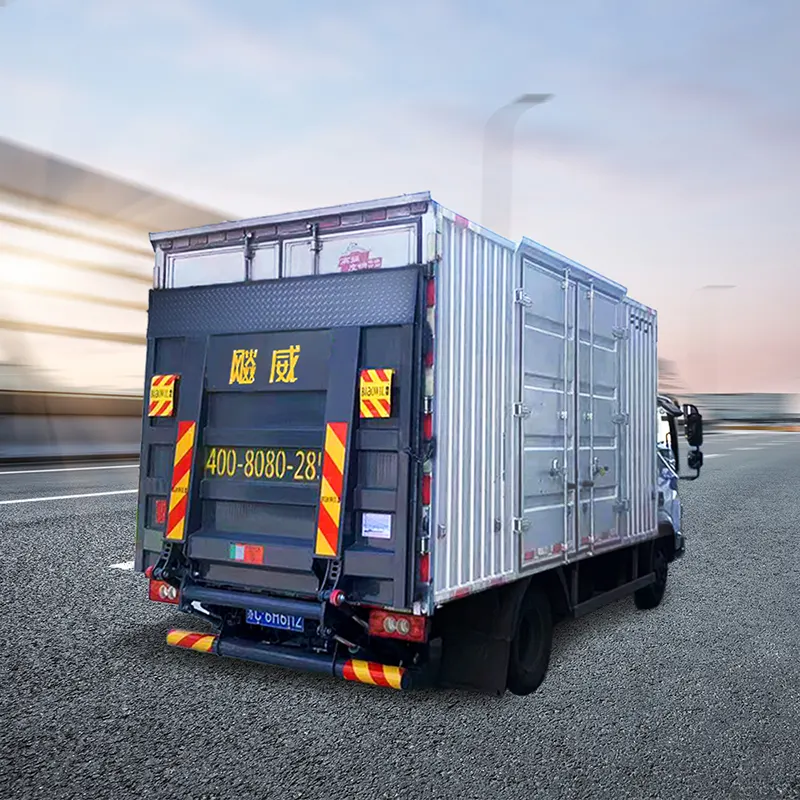꼬리 리프트는 어떻게 작동합니까??
Anhui-Beauway-Machinery-Manufacturing-Co-LTD-Launches-New-Tail-Lift-Products-Great-the-Loading and-enloading-efficiency of-trucks-and-logistics-vehicles
테일 리프트는 트럭 또는 밴의 후면에 부착 된 기계 장치입니다., 지면과 차량의화물 침대 사이의 상품을 들어 올리거나 낮추도록 설계되었습니다.. 테일 리프트의 작동 방식에 대한 설명은 다음과 같습니다, 단계별:
테일 리프트의 주요 구성 요소
- 유압 또는 공압 시스템: 플랫폼의 리프팅 및 하강을 전제하는 주요 메커니즘. 대부분의 꼬리 리프트는 유압 장치를 사용합니다, 일부는 공압 시스템을 사용할 수 있지만.
- 제어 장치: 일련의 컨트롤 (일반적으로 버튼이나 레버) 이를 통해 운영자가 올릴 수 있습니다, 낮추다, 또는 필요에 따라 플랫폼을 기울입니다.
- 리프팅 플랫폼: 들어 올리거나 하강하는 동안 하중을 유지하는 평평한 표면.
- 팔이나 레일을 들어 올립니다: 이들은 플랫폼을 차량에 연결하고 작동 중에 안정성을 제공합니다..
- 전원: 리프트는 일반적으로 차량의 전기 시스템에서 전력을 끌어냅니다., 배터리 나 발전기를 사용하여 유압 펌프를 작동합니다..
- 안전 메커니즘: 여기에는 한계 스위치와 같은 기능이 포함됩니다, 압력 릴리프 밸브, 사고 나 장비 고장을 방지하기위한 과부하 보호.
꼬리 리프트가 작동하는 방법: 단계별 프로세스
- 테일 리프트를 배포합니다:
스타트 업: 운영자는 제어판을 통해 테일 리프트를 활성화합니다., 일반적으로 차량 후면 근처에 있습니다.
플랫폼 전개: Tuckaway 또는 Slider 리프트와 같은 유형에서, 플랫폼은 차량 아래에 접 힙니다. 운영자는 플랫폼을 전개하고 평평하게 배치합니다, 로드 준비. - 플랫폼로드:
플랫폼이 완전히 배치되어지면에 위치하면, 운영자는화물을 리프트에로드합니다. 이것은 수동으로 또는 무거운 물건을 위해 팔레트 잭으로 수행 할 수 있습니다..
플랫폼은 일반적으로 상당한 무게를 처리 할 수 있습니다, 그러나 최대 용량이 있습니다 (종종 범위 500 kg ~ 몇 톤, 모델에 따라). - 하중을 들어 올립니다:
연산자는 "UP"컨트롤을 누릅니다, 유압 또는 공압 시스템 활성화. 유압 펌프는 유체를 리프팅 실린더로 강제합니다, 리프팅 암이나 레일을 확장합니다, 플랫폼이 상승하게됩니다.
플랫폼은 트럭 침대 수준으로 매끄럽게 올라갑니다.. 리프트는 안정을 유지하도록 설계되었습니다, 전체 프로세스 동안 레벨 위치. - 차량에 내린:
플랫폼이화물 침대의 높이에 도달하면, 운영자는 부하를 트럭 또는 밴으로 전송합니다..
플랫폼에는 종종화물이 이동하거나 떨어지는 것을 방지하기 위해 사이드 레일 또는 슬립 방지 표면과 같은 안전 기능이 있습니다.. - 플랫폼을 낮추고 있습니다:
언로드 후, 연산자는 "다운"컨트롤을 누릅니다. 이것은 유압을 방출합니다, 유체가 저수지로 다시 흐르고 리프트가 부드럽게 내려 오도록 허용합니다..
플랫폼은지면으로 돌아갑니다, 다음 하중을위한 준비가되거나 쫓아 낼 준비. - 꼬리 리프트를 훔칩니다:
모든 로딩 또는 언로드가 완료되면, 플랫폼은 스토리지 위치로 다시 접 힙니다 (Tuckaway 또는 슬라이더 모델의 경우) 또는 단순히 후퇴 (캔틸레버 및 컬럼 리프트의 경우).
작업자는 테일 리프트를 제자리에 고정시킵니다, 운송 중에 움직이지 않도록합니다.
안전 기능 및 고려 사항
제한 스위치: 이로 인해 플랫폼이 너무 높아 지거나 너무 낮아지는 것을 방지합니다., 장비와 운영자를 보호합니다.
과부하 보호: 부하가 리프트의 정격 용량을 초과하는 경우, 시스템은 작동하지 않습니다, 잠재적 손상 또는 사고 방지.
압력 릴리프 밸브: 이것은 수압이 안전한 한계를 초과하는 것을 방지합니다, 그렇지 않으면 기계적 고장을 유발할 수 있습니다.
기울기 메커니즘: 일부 꼬리 리프트 (캔틸레버 유형처럼) 고르지 않은 표면에 더 쉽게로드하거나 언로드 할 수 있도록 기울기 기능이 있습니다..
일반적인 응용 프로그램
배달 차량: 트럭 안팎으로 상품을 이동하기 위해, 특히 로딩 도크를 사용할 수없는 도시 환경에서.
건축 및 산업 사용: 중장비 또는 재료 운송.
이동 및 재배치: 무거운 가구를 다루기 위해, 가전 제품, 또는 다른 큰 물체.
요약, 테일 리프트는 매끄럽게 제공됩니다, 무거운 상품을 적재하고 언로드하기위한 기계적 솔루션, 큰 품목을 처리하기가 훨씬 쉽고 안전합니다., 특히 수동 리프팅이 어렵거나 위험한 곳.
